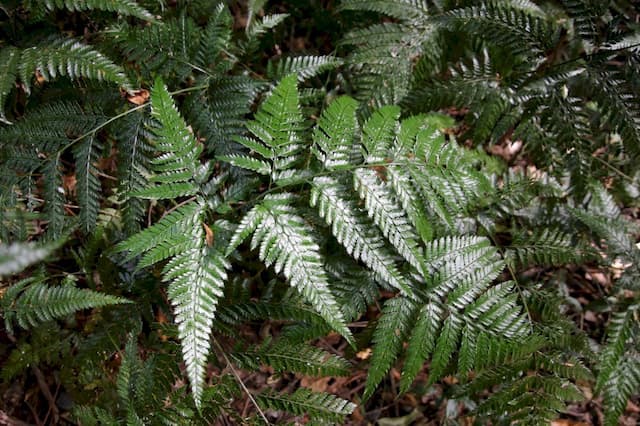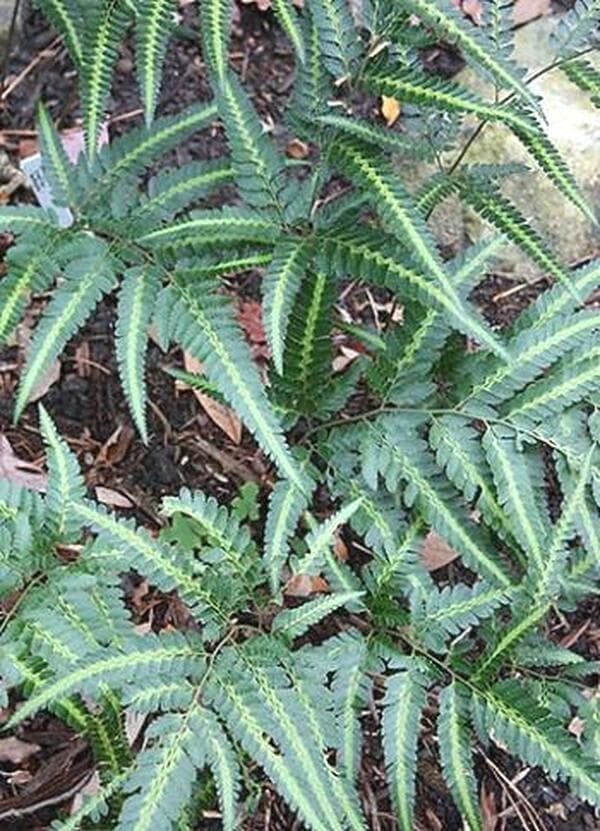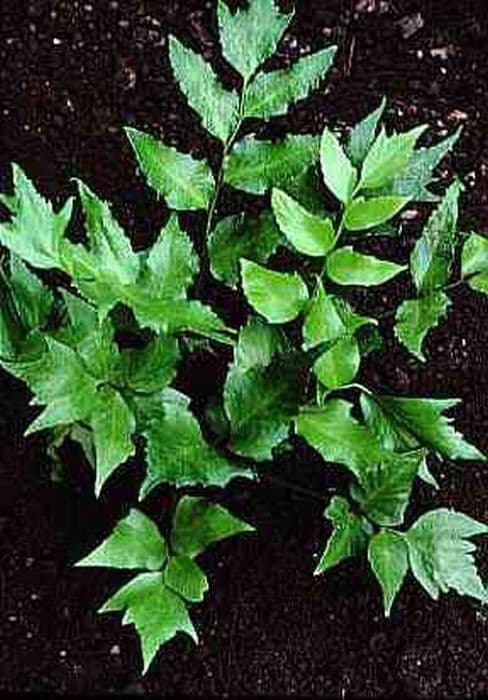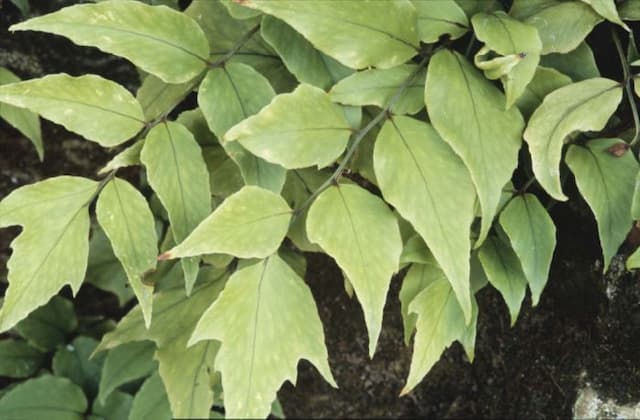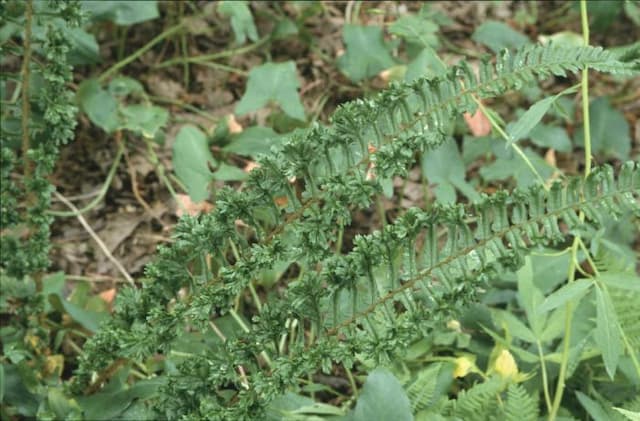Spinulose wood fern Dryopteris carthusiana

ABOUT
The plant known as the spinulose wood fern has a delicate and lacy appearance, with a lush green color that gives it a classic fern aesthetic. Its leaves, which are commonly referred to as fronds, have a feathery appearance, each composed of numerous small, leafy segments that line their length. The fronds usually form a clustered rosette shape, creating a dense and attractive tuft. Each of the leafy segments has tooth-like edges, which contribute to the plant's common name, as it appears to have a 'spinulose' or spiny texture when observed closely. The fronds are supported by a central stalk called the stipe, which is typically green to brown in color and may have a slightly scaly texture. This type of fern's natural growing habitat is often in shaded woodland areas, which allows it to thrive in the dappled light, adding to the picturesque quality of its environment.
About this plant
 Names
NamesFamily
Dryopteridaceae
Synonyms
Spinulose Wood Fern, Narrow Buckler Fern, Toothed Wood Fern, Spinulose Shield Fern
Common names
Aspidium carthusianum, Dryopteris austriaca var. spinulosa, Dryopteris spinulosa, Lastrea carthusiana, Nephrodium carthusianum, Polystichum carthusianum, Thelypteris carthusiana, Dryopteris carthusiana var. spinulosa.
 Characteristics
CharacteristicsLife cycle
Perennials
Foliage type
Deciduous
Color of leaves
Green
Height
2 feet (60 cm)
Spread
2 feet (60 cm)
Plant type
Fern
Hardiness zones
3
Native area
Eurasia
Benefits
 General Benefits
General Benefits- Ecosystem Support: Dryopteris carthusiana, commonly known as the Wood Fern, provides essential habitat for wildlife such as invertebrates, which in turn support birds and small mammals.
- Soil Stability: The root system of the Wood Fern helps to prevent soil erosion by stabilizing the soil, particularly in woodland areas and on slopes.
- Biodiversity: As a native species, the Wood Fern contributes to the biodiversity of forest ecosystems, supporting a wide range of flora and fauna.
- Aesthetic Value: With its lush green fronds, the Wood Fern is often used in landscaping and garden design for its natural beauty and texture.
- Culinary Use: Although not widely known, some fern species, including relatives of the Wood Fern, have fiddleheads that are harvested and eaten as a vegetable (note: proper identification is crucial, as some ferns can be toxic).
- Low Maintenance: Wood Ferns require minimal care once established, making them a sustainable choice for natural gardens and forest restoration projects.
- Educational Interest: The Wood Fern can be used for educational purposes, teaching about fern life cycles, reproduction through spores, and the role of understory vegetation in forest ecology.
- Climate Resilience: Ferns such as the Wood Fern are often resilient to changes in climate, making them a robust component of native plantings and ecosystem adaptations.
- Carbon Sequestration: Like all green plants, the Wood Fern engages in photosynthesis, capturing carbon dioxide from the atmosphere and helping to mitigate climate change impacts.
 Medical Properties
Medical Properties- Anthelmintic: Dryopteris carthusiana has been used traditionally to expel worms or parasites from the intestines.
- Astringent: The plant has properties that cause contraction of body tissues which could help reduce bleeding or secretions.
 Air-purifying Qualities
Air-purifying QualitiesThis plant is not specifically known for air purifying qualities.
 Other Uses
Other Uses- The fronds of Dryopteris carthusiana, also known as the Spinulose wood fern, can be used as a natural packing material due to their fibrous and resilient nature.
- These ferns can serve as a moisture indicator in gardens because they typically prefer damp environments, so their health can reflect soil moisture levels.
- Spinulose wood fern may be used in landscape design for erosion control on slopes, as their root systems help hold soil in place.
- Ferns including Spinulose wood fern are often used in shade gardens to create texture contrast with their finely divided leaves against broader-leaved plants.
- Dried fronds of the Spinulose wood fern can be used in craft projects, such as making bookmarks or adding to picture frames for a natural decorative touch.
- The Spinulose wood fern can be used in terrariums or bottle gardens, especially in temperate climates, to create a mini-forest aesthetic.
- These ferns can be planted to provide habitat and shelter for small wildlife, such as amphibians and insects, supporting biodiversity.
- Spinulose wood fern can be utilized in educational settings to teach about plant life cycles, particularly how non-flowering plants reproduce via spores.
- The plant can be used as a filler in floral arrangements, especially in rustic or woodland-themed designs, adding greenery and fullness.
- In historical reenactments or educational demonstrations, the Spinulose wood fern might be used to illustrate the types of native plants early settlers might have encountered.
Interesting Facts
 Feng Shui
Feng ShuiThe Wood Fern is not used in Feng Shui practice.
 Zodiac Sign Compitability
Zodiac Sign CompitabilityThe Wood Fern is not used in astrology practice.
 Plant Symbolism
Plant Symbolism- Resilience: Dryopteris carthusiana, commonly known as the spinulose wood fern or narrow buckler-fern, is a hardy perennial fern that can thrive in a variety of environmental conditions, symbolizing the ability to endure and adapt to life’s challenges.
- Protection: Ferns, in general, have a long history of being used for protective purposes in folklore, and the spinulose wood fern is no exception, embodying the desire to shield oneself or others from harm.
- Eternal youth: The fern's perennial nature and the consistent appearance of fresh fronds may be seen as a symbol of renewal and the quest for everlasting vitality and youth.
- Secret bond: In the Victorian language of flowers, ferns were often associated with secretiveness and discretion, possibly due to their hidden reproductive parts; Dryopteris carthusiana could be seen as representing an unspoken understanding or private connection.
- Reverie: The lush, green fronds of the spinulose wood fern may inspire a sense of fantasy or reverie, inviting the onlooker to indulge in imaginative thought and to escape into the wildness of nature.
 Water
WaterThe spinach wood fern should be watered once a week, providing enough water to moisten the soil throughout its root zone. Typically, this would amount to about 1 to 1.5 gallons of water per week, depending on the size of the plant and the environmental conditions. Ensure that the water reaches the roots, but take care not to overwater as this plant does not like to sit in waterlogged soil. During the growing season, maintain consistent moisture, but you can reduce watering frequency in the dormant winter months to prevent rot.
 Light
LightThe spinach wood fern thrives in partial to full shade. The ideal spot for this plant is one where it receives filtered sunlight or only a few hours of direct morning sun. Avoid placing it in harsh, direct afternoon sunlight as it can scorch the delicate fronds.
 Temperature
TemperatureSpinach wood ferns prefer cool to moderate temperatures, with the ideal range being between 60°F to 70°F. They can tolerate temperatures down to 50°F and up to 75°F. This fern is not suited for extreme heat or cold and should be protected from frost.
 Pruning
PruningPrune the spinach wood fern to remove any dead or damaged fronds, which promotes healthy growth and improves air circulation. The best time to prune is in the early spring, just before new growth begins. Pruning can be done annually or as often as needed to maintain the plant's appearance.
 Cleaning
CleaningAs needed
 Soil
SoilSpinulose Wood Fern thrives in a soil mix that is well-draining and rich in organic matter with a pH range of 5.5 to 6.5. A mix of two parts peat or coconut coir, one part perlite or coarse sand, and one part compost works well. Regularly check the pH to ensure it stays slightly acidic which is ideal for this fern.
 Repotting
RepottingSpinulose Wood Fern doesn't need frequent repotting and can be done every 2-3 years. This is generally enough to refresh the soil and provide more room for growth. Repotting in spring allows the fern to recover during its active growing season.
 Humidity & Misting
Humidity & MistingSpinulose Wood Fern prefers high humidity levels, typically above 60%. This mimics their natural habitat and keeps the fronds lush and green. It’s ideal for bathrooms or kitchens where the humidity is naturally higher or use a humidifier in drier rooms.
 Suitable locations
Suitable locationsIndoor
Place in shaded spot, ensure high humidity, water when topsoil dry.
Outdoor
Partial shade, moist well-draining soil, protect from drying winds.
Hardiness zone
3-8 USDA
 Life cycle
Life cycleThe Wood Fern (Dryopteris carthusiana) begins its life cycle as a spore that germinates in a suitable moist habitat. The germination leads to the growth of a gametophyte, a heart-shaped, small, green structure that supports sexual reproduction. Male and female sex organs develop on this gametophyte, leading to the production of sperm and eggs, which unite through water-mediated fertilization. The fertilization results in a sporophyte, the visible fern plant, which emerges from the gametophyte and will eventually develop fronds and a root system. As the sporophyte matures, it produces specialized fronds called sporangia, found on the undersides of the leaves, which house spores ready to be dispersed for the next generation. As a perennial, the Wood Fern can live for several years, going through a cycle of dormancy and growth with the seasons.
 Propogation
PropogationPropogation time
Spring to Summer
The most popular method of propagation for Dryopteris carthusiana, commonly known as the Spinulose Wood Fern, is through spores. These ferns produce spores on the underside of their fronds when they reach maturity, typically in the summer months. To propagate, one would collect the spores by cutting a fertile frond and storing it in a paper bag until the spores are released. The spores are then sown on the surface of a sterilized potting mix and kept at consistent humidity under indirect light. It can take several weeks to months for the spores to germinate and develop into gametophytes, which then produce the next generation of ferns through fertilization. This method requires patience and careful attention to moisture and temperature to ensure successful propagation.
